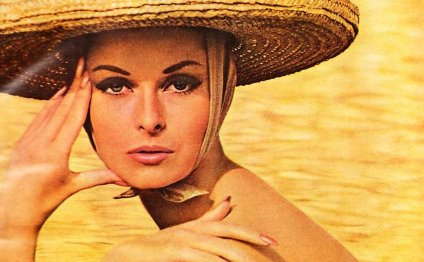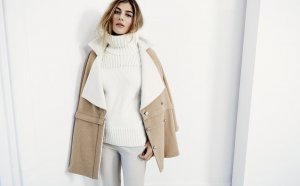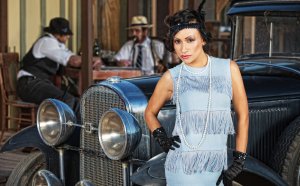
1964 Fashion trends
Continuing the trend begun in the latter element of 1963, ladies' fashions in 1964 moved still further from the right lines and severe tailoring of "hard stylish" to ever better fullness, softness, and feminine information. Some startling innovations also made style headlines, such as the highly influential discotheque trend, the temporary lived transparent night dress, in addition to more potent concepts of pants, culottes, and one-piece jumpsuits.
The Couture. As in 1963, Paris couture houses carried on to have additional declines in business amount. Despite monetary setbacks, however, Paris was able to manage its position as a prime source of important manner some ideas. Yves St. Laurent made gown development with his tiers and tunics, while Cristobal Balenciaga, whom also showcased tunics, effectively re-introduced the dolman sleeve plus the wraparound finishing in coats and fits.
Although Andre Courreges was usually towards the rounding and softening trend, he won great appeal and recognition for his exquisite pure-line tailoring, and particularly for his championing of pants for females, a campaign that received additional impetus from Gabrielle Chanel's less serious, small-scaled acceptance regarding the idea. The jeans idea has also been favored by United states designer Norman Norell, whom advanced the trouser suit for traveling and also offered their form of the culotte dress.
Marc Bohan of the Paris home of Dior impressed the style globe with outfits prompted by Russian types, and America's Oleg Cassini based his matched autumn series when it comes to home of Cassini regarding the Renaissance look. Rumblings of couture-to-come were additionally heard from budding youthful developers who were beginning. become seen in London and Madrid.
Spring.
The hard-seamed, tightly tailored look bowed call at the spring, as did the masculine sportive appearance. Using their place was the extremely processed, ultrafeminine, gentle lady look—dainty, delicate, delectable. Ruffles, pleats, plants, bows, billowy blousing, and subdued textiles and colors noted the change. A semblance of fit, however, performed remain. Without snug in the slightest, the brand new form was close from bosom to hip, accenting the midriff. From hips on down the focus was in the smooth, the easy, the animated, the elegant. Dresses, wider-hemmed and a trifle faster than in previous seasons, rippled and swirled with various pleats, panels, and flares. Stockings, sheerer and barer than previously, were delicately tinted to put just a blush of color on feet and current a continuing movement of shade from top to toe. Shoes were reduced, airier, plus available on every part, displaying these types of interesting textures as patent, reptile, kidskin, and calfskin, and ranging in shade from off-white through pale pastels and obvious brights to two-tone combinations with contrasting toe or lacquered heel.
Using the disappearance associated with square silhouette, the over-all look became skinny. Thin sleeves were set into thin normal shoulders; coats and suit jackets had been narrower, the latter being somewhat fitted and relatively brief. Collars became progressively crucial, lapels were larger, and necklines had been more available whilst still being much deeper and simpler on dresses.
In dresses the stretched-out appearance prevailed, usually on a chemise body—low pouches, reduced pleating, low belting in right back. Waistlines rose for evening, but were low by-day. For late day necklines plunged lower and lower, but had been softened with scarves, shawls, stoles, and wraps.
Materials had been generally smoother, less complicated, more subdued. Leading were wools, linens, gabardines, silks, cotton fiber piques, and lace, that has been seen everywhere.
Ebony and navy were preferred colors, with carnation-red an up-and-corner. White, but is at its height of popularity—whether made use of alone, or even to lighten and soften brighter colors, crisp the navy or black colored of a suit, or bleach a grainy reptile bag.
Consistent with the ultrafeminine trend, caps became more sensuous and processed, using the increased exposure of form in the place of ornamentation. The prominent form ended up being the big brim that scatter large; sweeping upward, plunging backward, or undulating in fascinating curves.
The boy-leg bikini base, featuring its abbreviated trunks that teasingly concealed ab muscles tops of upper thighs, ended up being used low-slung and belted within hip, and proved to he the entire year's sexiest seaside design, even though in conjunction with a less revealing camisole top and/or front-buttoned overvest that masked milady's middle.
Discothequery. The revival-with-a-vengeance regarding the black colored "little absolutely nothing" gown was motivated this time around by the atmospheric circumstances associated with the discotheque—a members-only night club where prominent, the young, together with striking could literally let their particular locks down while contorting toward latest recorded dance craze. The alleged discotheque dress had been shorter and swingier at the bottom, sparer and saucier at the top, with a-deep ruffle-framed decolletage or bare back, or both, together with skinny of band. The splurge of knee-baring discotheque clothes inspired a fresh size for slips and pettipants—well above hem level, but stretched with flips, flares, and lacy flounces.
Designers in addition translated the discotheque trend into extremely black decollete knee-high or more sleep-slips, sleep-shifts, and sleep-dresses, ruffled in the hem and edged with frilly lace during the top leap. The greatest boudoir manner development, however, had been the return regarding the pajama in deluxe materials particularly velveteen, crepe, jewel-toned brocades, and metallic knits.
The discotheque design also left its stamp on such add-ons as gloves, bags, and jewelry. Discotheque gloves were frequently black, typically of stretch nylon, satin, or lace, and never infrequently fringed with jet. Black alligator or lizard bags associated with the thin envelope or suspended-from-the-shoulder types had been associated with a golden string. Go-with jewelry was precious jewelry that moved—long, dangling earrings, low-slung pendants, and serpentine bracelets of silver encrusted with semiprecious rocks.
Hosiery designers came up with more fine of styles for absolute, stretchy, lacy black colored stockings that gently besprinkled, the legs with soft openwork habits of movie stars, diamonds, crowns, medallions, snowflakes, and fleurs-de-lis.
Share this Post
Related posts
Winter Style
WinterStyle.com specializes in premium quality winter months outerwear accessories. Discover the seasons hottest winter months…
Read More1920s Fashion trends
Facts about the 1920 s Fashion for females 1920 s Fashion History Truth 11: Art Deco fashions: Art Deco fashions arrived…
Read More










